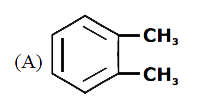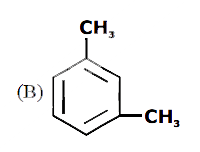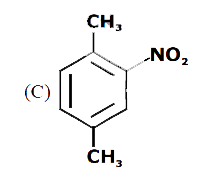Ring nitration of dimethyl benzene results in the formation of only one nitro dimethyl benzene. The dim-ethyl benzene is :



None of these
The correct Answer is:C
To determine which dimethylbenzene results in the formation of only one nitro dimethylbenzene upon nitration, we need to analyze the structure of dimethylbenzene (also known as xylene) and the positions of the methyl groups.
1. Identify the Isomers of Dimethylbenzene:
- Dimethylbenzene has three possible isomers based on the positions of the two methyl groups:
- Ortho-dimethylbenzene (1,2-dimethylbenzene)
- Meta-dimethylbenzene (1,3-dimethylbenzene)
- Para-dimethylbenzene (1,4-dimethylbenzene)
2. Analyze the Nitration Reaction:
- Nitration involves the substitution of a hydrogen atom on the benzene ring with a nitro group (NO2).
- The methyl groups (–CH3) are electron-donating groups, which activate the benzene ring and direct the incoming nitro group to the ortho and para positions relative to themselves.
3. Determine the Possible Products for Each Isomer:
- Ortho-dimethylbenzene:
- The methyl groups will direct the nitro group to the ortho and para positions. Therefore, two different nitro derivatives can be formed:
- 2-nitro-1,2-dimethylbenzene (ortho)
- 4-nitro-1,2-dimethylbenzene (para)
- Thus, this isomer gives two products.
- Meta-dimethylbenzene:
- The methyl groups will direct the nitro group to the meta position. However, the meta position does not allow for the formation of a para product. Thus, only one nitro derivative can be formed:
- 3-nitro-1,3-dimethylbenzene (meta)
- This isomer also gives two products (one at the meta position, but no para).
- Para-dimethylbenzene:
- The methyl groups will direct the nitro group to the ortho and para positions. Thus, two different nitro derivatives can be formed:
- 2-nitro-1,4-dimethylbenzene (ortho)
- 4-nitro-1,4-dimethylbenzene (para)
- This isomer gives two products as well.
4. Identify the Isomer that Forms Only One Product:
- From the analysis, the only isomer that leads to the formation of only one distinct nitro dimethylbenzene is meta-dimethylbenzene (1,3-dimethylbenzene). This is because it does not allow for the formation of a para product, leading to only one possible nitro derivative.
Conclusion:
The dimethylbenzene that results in the formation of only one nitro dimethylbenzene upon nitration is meta-dimethylbenzene (1,3-dimethylbenzene).
---
- Dimethylbenzene has three possible isomers based on the positions of the two methyl groups:
- Ortho-dimethylbenzene (1,2-dimethylbenzene)
- Meta-dimethylbenzene (1,3-dimethylbenzene)
- Para-dimethylbenzene (1,4-dimethylbenzene)
- Nitration involves the substitution of a hydrogen atom on the benzene ring with a nitro group (NO2).
- The methyl groups (–CH3) are electron-donating groups, which activate the benzene ring and direct the incoming nitro group to the ortho and para positions relative to themselves.
- Ortho-dimethylbenzene:
- The methyl groups will direct the nitro group to the ortho and para positions. Therefore, two different nitro derivatives can be formed:
- 2-nitro-1,2-dimethylbenzene (ortho)
- 4-nitro-1,2-dimethylbenzene (para)
- Thus, this isomer gives two products.
- Meta-dimethylbenzene:
- The methyl groups will direct the nitro group to the meta position. However, the meta position does not allow for the formation of a para product. Thus, only one nitro derivative can be formed:
- 3-nitro-1,3-dimethylbenzene (meta)
- This isomer also gives two products (one at the meta position, but no para).
- Para-dimethylbenzene:
- The methyl groups will direct the nitro group to the ortho and para positions. Thus, two different nitro derivatives can be formed:
- 2-nitro-1,4-dimethylbenzene (ortho)
- 4-nitro-1,4-dimethylbenzene (para)
- This isomer gives two products as well.
- From the analysis, the only isomer that leads to the formation of only one distinct nitro dimethylbenzene is meta-dimethylbenzene (1,3-dimethylbenzene). This is because it does not allow for the formation of a para product, leading to only one possible nitro derivative.
The dimethylbenzene that results in the formation of only one nitro dimethylbenzene upon nitration is meta-dimethylbenzene (1,3-dimethylbenzene).
Topper's Solved these Questions
- AROMATIC COMPOUNDBook:MOTIONChapter:AROMATIC COMPOUNDExercise:Exercise - 2 (Level-II)
Explore 29 Videos
- AROMATIC COMPOUNDBook:MOTIONChapter:AROMATIC COMPOUNDExercise:Exercise - 3
Explore 17 Videos
- AROMATIC COMPOUNDBook:MOTIONChapter:AROMATIC COMPOUNDExercise:Exercise - 4 | Level-II
Explore 16 Videos
- ALKYI HALIDEBook:MOTIONChapter:ALKYI HALIDEExercise:Exercise - 4 | Level-II
Explore 8 Videos
- ATOMIC STRUCTURE Book:MOTIONChapter:ATOMIC STRUCTURE Exercise:EXERCISE-4 (LEVEL-II)
Explore 18 Videos
Similar Questions
Knowledge Check
The nitration of benzene is :
ASN1 reactionBSN2 reactionCSE1 reactionDSE2 reactionThe show step in the nitration of benzene involves the formation of
A B
B C
C D
D
Nitration of benzene is carried out with :
AHNO3(dil.)BHNO3(conc.)CHNO3(fuming)D(HNO3(conc.)+H2SO4(conc.)
